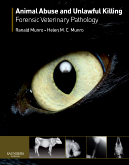|
|
|
| |
 |
|
|

|
-
推薦指數:





|
|
- 內容介紹
|
Animal Abuse and Unlawful Killing - Forensic veterinary pathology
By Ranald Munro, BVMS, MSc, DVM, Dip Forensic Medicine, DipECVP, MRCVS and Helen M. C. Munro, BVMS, MRCVS
124 pages
Trim Size 9 11/16 X 7 7/16 in
Copyright 2008
Description
This book guides veterinarians and lawyers through the diverse and complex fields of alleged cruelty to, and unlawful killing of, companion animals, farm livestock and wildlife. It draws together current knowledge on how to approach, investigate and report forensic cases
Table of Contents
Introduction
Definition of forensic veterinary pathology – a developing specialty.
The relationship between the forensic veterinary pathologist and the courts.
Why do it?
The forensic examination and report
The locus: types of loci, value of attending at the locus, notes and photographs
The forensic necropsy procedure: standard procedures, avoidance of pitfalls, natural disease
Interpretation of findings
Report writing: plain English, formatting and numbering
Estimation of the post mortem interval
Rigor mortis, post mortem changes including adipocere and mummification, immunohistochemistry, entomology and environmental clues
Wounds and other injuries
Superficial injuries: skin wounds including abrasions, incisions, lacerations and stab wounds
Bruising and haemorrhage
Internal injuries: blunt trauma; penetrating wounds; head; thoracic; abdominal; pelvic and limb injuries
Non- accidental injury
Terminology and definitions
Features that raise suspicion
Links to violence in the home
Limitations on application of current knowledge to non-companion animals
Asphyxia and Drowning
Definition of asphyxia
General features
Strangulation, Choking & Smothering, Suffocation & Crush Asphyxia, Poisonous gases, Smoke inhalation, Drowning
Firearms
Types of weapons and ammunition: air rifles, shotguns, rifles and crossbows
Firearm injuries: air rifle pellets wounds, shotgun pellet wounds, high and low velocity rifle bullet wounds
Traps and snares
Illegal use of traps and snares
Injuries caused by spring traps
Injuries caused by snares
Deaths in cage traps
Dog bite injuries
Injuries to hares killed during hare coursing
Injuries to roe deer seized by dogs
Injuries to domestic livestock following stock worrying
Poisoning
Necropsy features raising suspicion of chemical poisoning
Thermal injuries
Burns and scalds
Pathologic features in cats fatally injured in microwave ovens and tumble dryers
Electrocution
Heatstroke
Frostbite
Neglect
Dogs, cats, other domestic pets and livestock: deprivation of the normal necessities of life
Lack of veterinary treatment: chronic lameness in livestock; neglected injuries; neoplasia; diarrhoea; loss of weight
Sexual abuse
Terminology
Types of injuries in companion animals
Objects used
Estimation of the age of lesions
Bruises, healing wounds, fractures, peri-osteal responses
Use of histopathology in forensic cases
Confirmation or exclusion of specific changes or lesions.
Smoke inhalation
|
|

歡迎使用國民旅遊卡
|
 其他相關書藉
其他相關書藉
|
|
|
|
|
| ◆ Dellmann's Textbook of Veterinary Histology with CD Sixth Edition(已絕版) |
| - 獸醫科 |
| - 作者:Jo Ann Eurell and Brian L. Frappier |
| ◆ Stedman's Medical Dictionary, 27th Edition, Featuring New Veterinary Medicine Insert with over 45 Images and Reference T |
| - 獸醫科 |
| - 作者:Tilley |
| ◆ Color Atlas of Veterinary Anatomy, Volume 3, The Dog and Cat, 2/E 2009 |
| - 獸醫科 |
| - 作者:Stanley H. Done, BA, BVetMed, PhD |
| ◆ Managing a Veterinary Practice, 2nd Edition |
| - 獸醫科 |
| - 作者:Caroline Jevring-Back, BVetMeds |
| ◆ BSAVA Manual of Canine and Feline Clinical Pathology 3/E 2016 |
| - 獸醫科 |
| - 作者:Elizabeth Villiers |
|
--- more |
 [ 積點系統 ]
[ 積點系統 ]
|
| 您已經累積多少點數您知道嗎?別忘了登錄會員,察看您的點數,獎品就等您來拿喲! |
 [ 訂購辦法 ]
[ 訂購辦法 ]
|
| 您還不知道要在本網站如何購物嗎?我們將會提供給您訂購的方法及購物相關資訊喲!讓您彈指間取得想要的書藉。 |
| |
|

